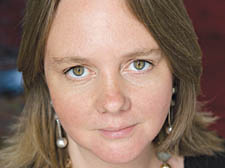|
|
 |
| |

Franny Moyle |
Franny’s frisson from the Romantics
Never mind the po-faced tutting critics, Franny Moyle is revelling in the blatant sex in the lives and works of the Pre-Raphaelites, writes Gerald Isaaman
DESPERATE ROMANTICS.
By Franny Moyle.
John Murray £8.99
FRANNY Moyle confesses that she was something of a punk teenager in the 1970s, in love not with some unshaven pop star but with William Morris, the prophet of peace and perfect design whose influence still permeates today.
“I was in love with him – totally enthralled by his quest for Utopias, his dedication to craft, and the inherent tragedy in his work and story,” she says.
So it doesn’t take a huge leap in imagination to see how, after working for 15 years in TV arts productions for the BBC, her desire to write resulted in a book about the love triangle between William Morris, Jane Morris and Dante Gabriel Rossetti.
But there were no takers. So she extended the book’s scope to take in the entangled Pre-Raphaelite lives – and lustful loves – of the artist child prodigy John Everett Millais and William Holman Hunt.
She added in the tormented personal life of the radical art critic John Ruskin, patron of the rebellious trio who came together in 1848, the year of revolutions when the defiant Chartists were on the march, and busted the smug world of Victorian art with the energy and zeal of truly passionate reformers.
It’s quite a hectic tale, packed with sex and dark drama. And Franny told it in her biography Desperate Romantics, which vividly paints the studios of Fitzrovia where they lived and the hypocritical social mores of a society split between poverty, prudery and outrageous scandal.
It was not so much an extension but an explosion and an echo of today’s celebrity culture.
“As soon as I mapped out the wider love triangles associated with the Brotherhood, I realised I had a far better story that showed a whole society in turmoil, not just three people,” explains Franny.
“And at that point I also realised there might be potential for a TV drama. So I pitched it to the BBC.”
And now, four years on, Desperate Romantics is being vividly revived on BBC2 in a six-part series written with remarkable verve by Peter Bowker, and starring Aidan Turner (Rossetti), Rafe Spall (Holman Hunt) and Samuel Barnett (Millais) as the three artistic musketeers.
It has provoked controversy, just as the Brotherhood did, between those who regard it as sordid improbable rubbish (Yuck, said one critic) and those enjoying the sheer bravura and irreverence of the saga, let alone the nice and naughty actresses playing the Brotherhood’s beautiful models.
Certainly it is fun, even if the TV production takes liberties with the facts, repeatedly showing off the artists drinking gin in dingy pubs when, in fact, they rejected alcohol, and lived at a time when, as today, the majority of couples rudely refused to marry and feared not the stuffy wrath of anyone.
Indeed, as executive producer Kate Harwood points out: “Desperate Romantics paints a modern, vivid and irreverent portrait of this group of painters whose attitude to the establishment makes them comparable to the punks 100 years later.”
Franny, who lives in Islington, deflects the arrows hurled at her. “Some of the critics have had a total sense-of-humour bypass,” she politely suggests.
“I think they have come to the project with expectations that we would be reverent, and when they discovered that Pete Bowker has found so much irony and humour in the tale, they just haven’t been able to compute. Brian Sewell [the art critic] and I had a great conversation about this. He, like me, sees so much sex, blatant sex, in Pre-Raphaelite work. It’s such an irony that in the modern world we are so prudish about drama that forefronts sex. I suggest the critics try to dump their preconceptions and loosen up a bit.”
It is not as if Franny has overturned the admired and accepted biographies of Jan Marsh, Fiona McCarthy and Tim Hilton in cleverly bringing together the Brotherhood set, as well as doing her own research in the Bodleian Library in Oxford and as far afield as Pierpont Morgan Library in New York. She also visited the scenes of the artistic revolution, Charlotte and Cleveland streets, and Gower Street, where Millais’ house still exists.
While we can object to the fact that TV can transform the truth – pictures do often distort and lie – it is a different art form to painting and literature. “It is important to understand that TV drama is driven by its own needs and conventions,” Franny insists. “There are rules of time and place that operate differently from literature, and whereas a novelist or writer has pages and pages to reveal his or her character, a TV writer has to deliver characterisation much more succinctly and immediately.
“So I never expect TV adaptations to be ‘like’ the book. They should be seen as works in their own right. If they can create a compelling world that immerses and engages a viewer, then they have succeeded.”
Buy the book, watch the series and decide for yourself.
|
 |
|
|
 |
 |
|
 |
|


